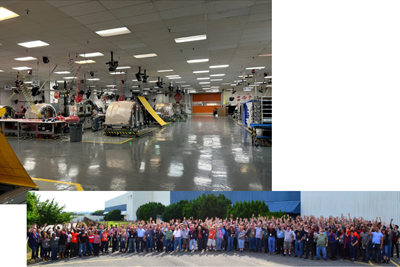Past, Present and Future Column
The evolution, transformation of DEA from lab measurements to industrial optimization
Over the years, dielectric analysis (DEA) has evolved from a lab measurement technique to a technology that improves efficiency and quality in composites production on the shop floor.
Composites opportunities in eVTOLs
As eVTOL OEMs seek to advance program certification, production scale-up and lightweighting, AAM’s penetration into the composites market is moving on an upward trajectory.
Read MoreOpportunities and challenges for composites in electric vehicles
Polymer and material specialists at chemical consulting firm ChemBizR reflect on the role of composites in current and future efforts to make electric vehicles more efficient — and more attractive for consumers.
Read MoreAugmenting engineered thermoplastics with natural fibers
The Paris Climate Accord mandate for net-zero carbon by 2050 has kick-started an innovation revolution for natural fibers and sustainably engineered resins.
Read MoreFrom sailplanes to composites repair: Growing composite training opportunities over the years
Mike Hoke discovered his interest in the composites industry at a young age. His journey eventually led him to Abaris Training Resources, which he owned and evolved for more than 30 years.
Read MoreRegional air mobility: A meaningful first step in the electric aviation revolution
Electrification of fixed-wing, <50-seat regional aircraft might stimulate a new era of growth that could help pave the way for advanced air mobility (AAM) aircraft.
Read MoreSetting unrealistic expectations in composites manufacturing
In the aerospace composites industry, quality comes at a cost, but built-in incentives throughout the supply chain don’t always favor the best and the brightest.
Read MoreThe next-generation single-aisle: Implications for the composites industry
While the world continues to wait for new single-aisle program announcements from Airbus and Boeing, it’s clear composites will play a role in their fabrication. But in what ways, and what capacity?
The compelling argument for expanded use of carbon fiber composites
Contributing columnists from Aramco explain that decreasing carbon fiber prices and continued innovations may allow carbon fiber composites to expand into new markets, including increased use in oil and gas applications.
Read MoreDefining the landscape for wind blades at the end of service life
There is a generation of wind turbine blades at or near the end of their useful life. Disposing of them, recycling them or reusing them requires a better understanding of the blade end-of-life landscape.
Read MoreBest practices in the CNC machining of composites
Machining composite materials is a challenging task. Proper tool selection, machine settings and process innovations help make it manageable.
Read MoreValuable data: From travelers to the as-built digital twin
Taking advantage of the electronic record proves to be of significant value to composite fabricator’s record-keeping process.
Read MorePart 2: Performance and safety benefits of prepregs
Returning with his second installment, Brian Bishop discusses the performance and safety benefits to using prepreg, and the value they can bring to composites fabricators.
Read MoreRediscovering the benefits of prepregs in composites manufacturing
Compared to more traditional forms of composites manufacturing, prepregs enable reduced manufacturing costs and enhance production performance.
Read MoreHow AI is improving composites operations and factory sustainability
Workforce pain points and various logistical challenges are putting operations resilience and flexibility to the test, but Industry 4.0 advancements could be the key to composites manufacturers’ transformation.
Boron fiber: The original high-performance fiber
History and future developments for high-performance boron fiber.
Read MoreFiberglass composites improve infrastructure efficiency and sustainability
Gert de Roover, building, construction and infrastructure manager at Exel Composites, explains why composite materials contribute to the drive for greener buildings.
Read MoreDeveloping new solutions for noise, vibration and harshness
Several recent IACMI partner projects focus on technology innovation related to challenges in noise, vibration and harshness (NVH) in vehicle design.
Read MoreDeveloping new solutions to multimaterial joining
Several recent IACMI partner projects focus on technology innovation related to challenges in multimaterial joining for the wind and automotive sectors.
Read MoreEnabling a circular economy approach to advanced composites innovation, manufacturing and use, Part 2
IACMI chief technology officer Uday Vaidya reflects on IACMI’s role in improving composites’ recyclability and reusability.
Read MoreEnabling a circular economy approach to advanced composites innovation, manufacturing and use, Part 1
In part 1 of a two-month column, IACMI chief technology officer Uday Vaidya reflects on the organization’s efforts to reduce the embodied energy of composites.
Read MoreReducing accidental separator inclusion in prepreg layup
ST Engineering MRAS discusses the importance of addressing human factors to reduce separator inclusion in bonded structures.
IACMI: Driving innovation in the advanced composites industry
Since its start in 2015, the Institute for Advanced Composites Manufacturing Innovation (IACMI) has come a long way in its mission of advancing composites innovation. CTO Uday Vaidya reflects on the past five years.
Read MoreThe Rubik’s Cube of working efficiently with different composite materials
Each member of an aerospace OEM’s supply chain works on a different side of the project, ultimately driving toward the same goal: a better composite-intensive aircraft.
Read MoreRiding the rollercoaster that is the aerospace industry
The Boeing’s 787 and the Airbus A350 XWB plunged the commercial aerospace supply chain into a period of instability from which it has only just emerged. The next generation of commercial aircraft production promises to be just as tumultuous.
Read MoreNatural fiber composites: What’s holding them back?
Natural fiber reinforcements have been available for some time, but factors such as compatibility with current processes and geographic availability continue to limit widespread use.
Read MoreCan the aerospace industry regain its ability to "try"?
TPI Composites’ Steve Nolet reflects on the strides that composites in the aerospace industry have made in the past fifty years, while also wondering if the industry could regain the space race era desire to test limits.
Read More3D printing is missing the third dimension
Emerging processes like continuous fiber manufacturing, in-situ consolidation and tool-less manufacturing are bringing composite 3D printing into the third dimension.
Read More












.jpg;maxWidth=300;quality=90)

